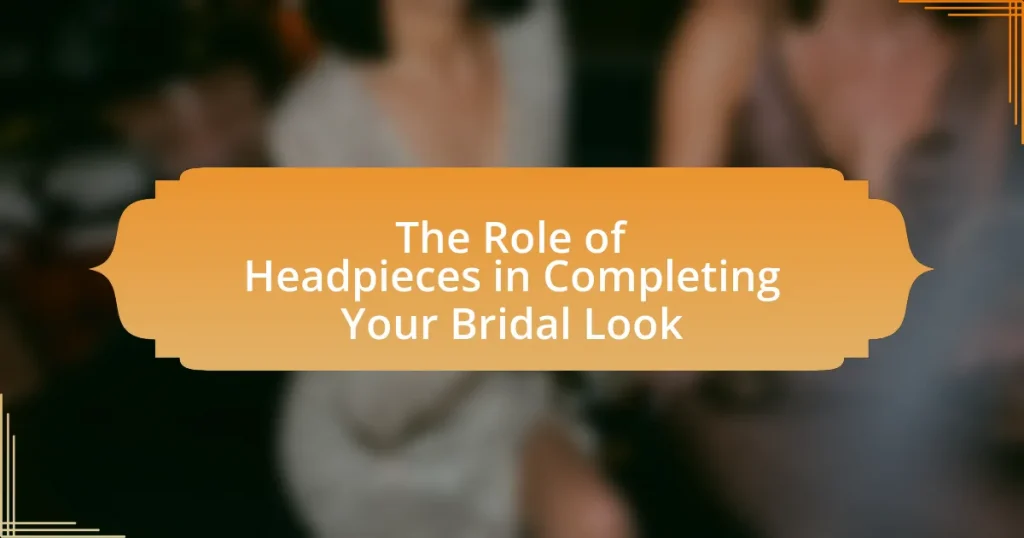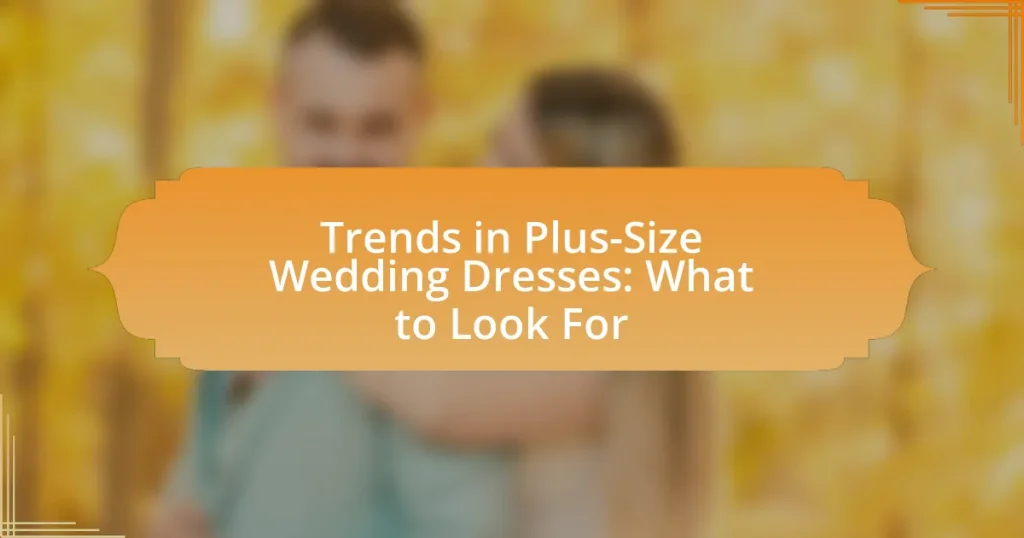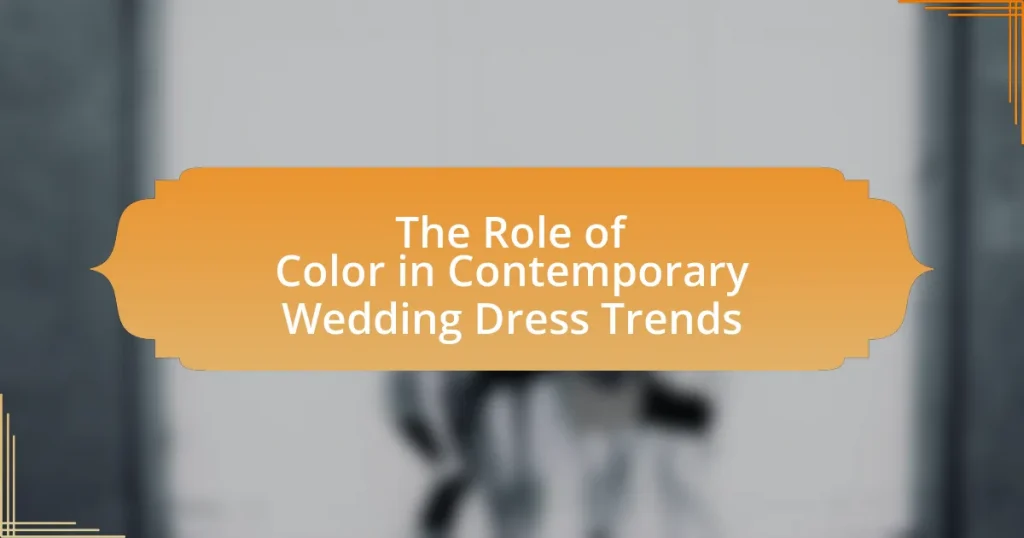Headpieces play a crucial role in completing a bridal look, enhancing the overall aesthetic while symbolizing cultural and personal significance. This article explores the various styles of headpieces, including veils, tiaras, headbands, and floral crowns, and their impact on different bridal gown styles. It discusses how headpieces reflect personal style and cultural heritage, their emotional influence on a bride’s confidence, and practical tips for selecting and securing the right headpiece for a wedding theme. Additionally, the article addresses budget considerations and common mistakes to avoid, providing a comprehensive guide for brides to achieve a cohesive and elegant appearance on their special day.
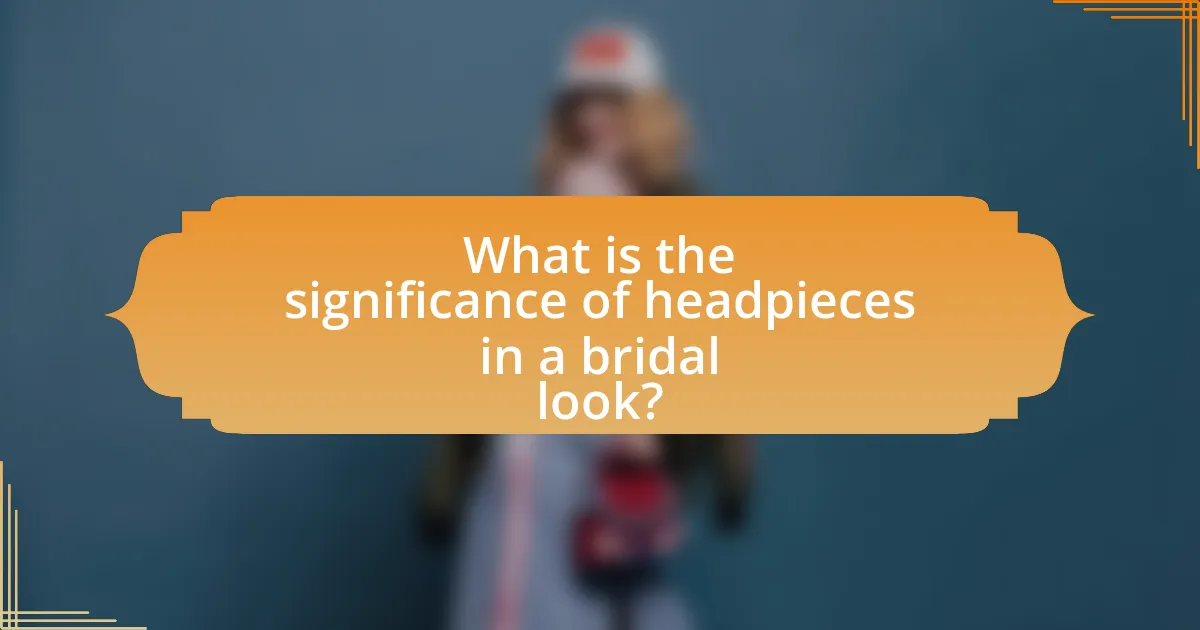
What is the significance of headpieces in a bridal look?
Headpieces are significant in a bridal look as they enhance the overall aesthetic and symbolize various cultural and personal meanings. They serve as a focal point that draws attention to the bride’s face, complementing her hairstyle and gown. Historically, headpieces have been used in many cultures to signify status, purity, and celebration, with examples ranging from veils to tiaras. The choice of headpiece can reflect the bride’s personality and style, making it an essential element in creating a cohesive and memorable bridal appearance.
How do headpieces enhance the overall bridal aesthetic?
Headpieces enhance the overall bridal aesthetic by adding elegance and a focal point to the bride’s appearance. They complement the wedding dress and hairstyle, creating a cohesive look that reflects the bride’s personal style. For instance, a veil can symbolize tradition and romance, while a floral crown may evoke a bohemian vibe. Studies show that accessories, including headpieces, significantly influence perceptions of beauty and style, reinforcing the idea that they play a crucial role in enhancing the bridal aesthetic.
What styles of headpieces are most popular among brides?
The most popular styles of headpieces among brides include veils, tiaras, headbands, and floral crowns. Veils are traditionally favored for their elegance and variety, ranging from short birdcage styles to long cathedral lengths. Tiaras are often chosen for their regal appearance, adding a touch of glamour to the bridal look. Headbands, which can be embellished with crystals or lace, offer a modern twist and versatility. Floral crowns have gained popularity for their romantic and bohemian aesthetic, often incorporating seasonal blooms. These styles reflect current bridal trends and preferences, showcasing the importance of headpieces in enhancing the overall bridal ensemble.
How do headpieces complement different bridal gown styles?
Headpieces enhance various bridal gown styles by adding elegance and completing the overall aesthetic. For instance, a simple gown can be elevated with a statement headpiece, such as a floral crown or a jeweled tiara, which draws attention and adds visual interest. Conversely, intricate gowns with heavy embellishments may benefit from more understated headpieces, like delicate hairpins or veils, to maintain balance without overwhelming the look. Historical trends show that headpieces have been used for centuries to signify status and style, reinforcing their role in bridal fashion.
Why are headpieces considered essential accessories for brides?
Headpieces are considered essential accessories for brides because they enhance the overall bridal look and symbolize elegance and tradition. Historically, headpieces have been worn by brides across various cultures, signifying purity and celebration. For instance, in Western traditions, veils and tiaras have been integral to bridal attire, often representing the transition from singlehood to marriage. Additionally, headpieces can complement the wedding dress and hairstyle, creating a cohesive aesthetic that elevates the bride’s appearance on her special day.
What emotional impact do headpieces have on a bride’s confidence?
Headpieces significantly enhance a bride’s confidence by serving as a focal point that complements her overall bridal look. The presence of a well-chosen headpiece can elevate a bride’s self-esteem, making her feel more beautiful and special on her wedding day. Research indicates that accessories, including headpieces, can influence self-perception and body image, leading to increased confidence levels. For instance, a study published in the Journal of Fashion Marketing and Management found that wearing aesthetically pleasing accessories positively affects individuals’ self-confidence and social presence. Thus, headpieces not only complete the bridal ensemble but also play a crucial role in boosting a bride’s emotional state on her significant day.
How do headpieces reflect personal style and cultural significance?
Headpieces reflect personal style and cultural significance by serving as a visual representation of individual identity and heritage. For instance, a bride may choose a modern floral crown to express her contemporary aesthetic, while another may opt for a traditional veil that signifies cultural customs, such as those seen in various religious ceremonies. Historical context supports this, as headpieces have been used across cultures for centuries, from the ornate tiaras of European royalty to the intricate hairpieces worn in African tribal ceremonies, each symbolizing status, tradition, or personal expression. Thus, headpieces are not merely decorative; they encapsulate the wearer’s values, beliefs, and stylistic preferences.

What types of headpieces are available for brides?
Brides have access to various types of headpieces, including veils, tiaras, headbands, hairpins, and floral crowns. Each type serves a unique purpose in enhancing the bridal look; for instance, veils can add a traditional touch, while tiaras offer a regal appearance. According to bridal fashion experts, the choice of headpiece often reflects personal style and the overall theme of the wedding, making it a crucial element in completing the bridal ensemble.
What are the differences between veils, tiaras, and hairpins?
Veils, tiaras, and hairpins serve distinct purposes in bridal attire. A veil is a piece of fabric that covers the face or head, often symbolizing modesty and tradition, and can vary in length and style, such as a cathedral or fingertip veil. Tiaras are ornamental headpieces, typically made of precious metals and adorned with gemstones, representing elegance and royal status, often worn to enhance the overall bridal look. Hairpins, on the other hand, are smaller accessories used to secure hairstyles, often embellished with pearls or crystals, providing both functionality and decorative flair. Each of these headpieces contributes uniquely to the bridal aesthetic, with veils emphasizing tradition, tiaras adding a touch of luxury, and hairpins offering practical styling solutions.
How do veils vary in length and style?
Veils vary in length and style, with common lengths including birdcage (short), shoulder (medium), elbow (longer), fingertip (even longer), chapel (floor-length), and cathedral (dramatic). Each style serves different aesthetic purposes and complements various bridal gowns; for instance, a birdcage veil adds a vintage touch, while a cathedral veil creates a grand, formal look. The choice of veil length and style is influenced by factors such as the wedding theme, dress design, and personal preference, ensuring that the veil enhances the overall bridal appearance.
What materials are commonly used in tiaras and hairpins?
Tiaras and hairpins are commonly made from materials such as metal, gemstones, pearls, and crystals. Metal, often in the form of gold, silver, or alloy, provides structural integrity and a luxurious appearance. Gemstones and pearls add elegance and sparkle, while crystals are frequently used for their affordability and ability to mimic the look of more expensive stones. These materials are chosen not only for their aesthetic appeal but also for their durability, ensuring that the headpieces can withstand the rigors of wear during events like weddings.
How can brides choose the right headpiece for their wedding theme?
Brides can choose the right headpiece for their wedding theme by considering the overall aesthetic and style of their wedding. For instance, a vintage-themed wedding may pair well with a classic birdcage veil or a floral crown, while a modern wedding might suit sleek, minimalist headbands or geometric hairpieces. Additionally, brides should match the materials and colors of the headpiece with their gown and other accessories; for example, a pearl-encrusted headpiece complements a gown with similar embellishments. This approach ensures cohesion in the bridal look, enhancing the overall theme and style of the wedding.
What factors should be considered when matching a headpiece to a wedding theme?
When matching a headpiece to a wedding theme, factors such as the overall style of the wedding, color palette, and the bride’s dress design must be considered. The wedding theme dictates the aesthetic, whether it is rustic, vintage, modern, or bohemian, influencing the choice of materials and designs for the headpiece. For instance, a vintage-themed wedding may pair well with a delicate lace or pearl-encrusted headpiece, while a modern wedding might suit a sleek, minimalist design. Additionally, the color palette should align with the headpiece to ensure harmony; for example, metallic tones can complement a glamorous theme, while floral accents may enhance a garden wedding. Lastly, the headpiece should coordinate with the bride’s dress style, such as matching the embellishments or silhouette, to create a cohesive bridal look.
How do seasonal trends influence headpiece choices?
Seasonal trends significantly influence headpiece choices by dictating styles, materials, and colors that align with the prevailing fashion of each season. For instance, spring often sees lighter fabrics and floral embellishments, while winter trends may favor heavier materials and jewel tones. This alignment with seasonal aesthetics ensures that headpieces complement the overall bridal look, enhancing the harmony of the ensemble. Additionally, designers often release collections that reflect seasonal themes, further guiding brides in their selection process.
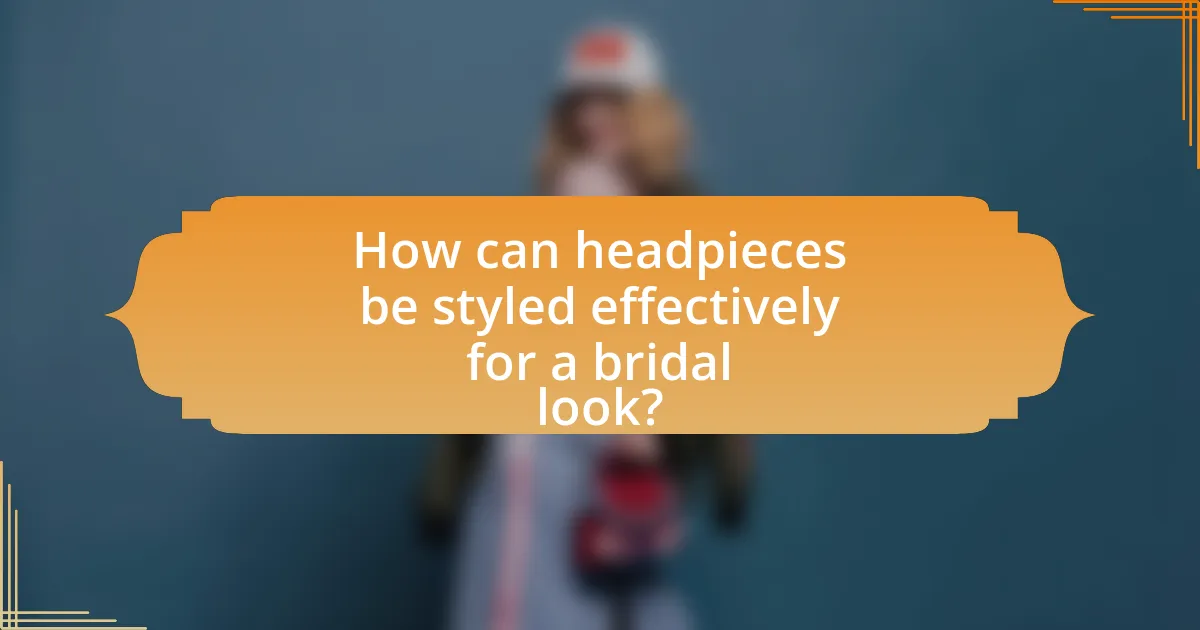
How can headpieces be styled effectively for a bridal look?
Headpieces can be styled effectively for a bridal look by selecting designs that complement the wedding dress and overall theme. For instance, a delicate floral crown pairs well with a bohemian gown, while a classic veil enhances a traditional dress. Additionally, positioning the headpiece at the right angle, such as slightly tilted or centered, can create a balanced appearance. According to bridal fashion experts, the choice of materials—like lace, pearls, or crystals—should align with the dress’s embellishments to ensure harmony in the overall look.
What tips can brides follow to wear headpieces confidently?
Brides can wear headpieces confidently by selecting styles that complement their overall bridal look and personal style. Choosing a headpiece that matches the dress’s fabric, color, and embellishments ensures a cohesive appearance. Additionally, practicing wearing the headpiece before the wedding day helps brides become accustomed to its fit and feel, reducing anxiety. Securing the headpiece properly with bobby pins or combs prevents it from shifting during the event, allowing for peace of mind. Finally, brides should consider their hairstyle; a headpiece should enhance the chosen hairstyle rather than overpower it, creating a balanced and elegant look.
How should brides consider their hairstyle when selecting a headpiece?
Brides should consider their hairstyle’s shape and volume when selecting a headpiece to ensure a harmonious look. For instance, an updo may pair well with a tiara or a floral crown, while loose waves might complement a headband or hairpins. The balance between the headpiece and hairstyle is crucial; a large headpiece can overwhelm a simple hairstyle, while a delicate piece may get lost in a voluminous style. Additionally, the headpiece should enhance the overall bridal aesthetic, aligning with the dress and theme of the wedding.
What are common mistakes to avoid when wearing headpieces?
Common mistakes to avoid when wearing headpieces include choosing a style that clashes with the overall bridal look, failing to secure the headpiece properly, and neglecting to consider the hairstyle. A headpiece that does not complement the dress or theme can disrupt the visual harmony of the bridal ensemble. Additionally, an improperly secured headpiece may shift or fall during the event, causing discomfort and distraction. Lastly, overlooking the hairstyle can lead to a mismatched appearance, as certain headpieces work better with specific hair types and styles.
What practical advice can brides use when selecting headpieces?
Brides should consider their wedding dress style, hair type, and overall theme when selecting headpieces. Matching the headpiece to the dress ensures a cohesive look; for example, a vintage dress pairs well with a vintage-inspired headpiece. Additionally, the hair type influences the choice; for instance, brides with long hair may opt for a tiara or floral crown, while those with short hair might choose a headband or comb. The wedding theme also plays a crucial role; a bohemian wedding may call for a more relaxed, nature-inspired piece, while a formal ceremony might require something more elegant and structured. This approach ensures that the headpiece enhances the overall bridal aesthetic rather than detracting from it.
How can brides ensure their headpiece stays secure throughout the day?
Brides can ensure their headpiece stays secure throughout the day by using a combination of proper attachment methods and supportive accessories. Securing the headpiece with bobby pins or hairpins that match the hair color can provide stability, while using a strong hold hairspray can help maintain the hairstyle and prevent slippage. Additionally, selecting a headpiece designed with a comb or elastic band can enhance security, as these features are specifically engineered to grip the hair effectively. Studies in bridal fashion indicate that brides who utilize these methods experience fewer issues with headpiece displacement during events, confirming the effectiveness of these strategies.
What budget considerations should brides keep in mind for headpieces?
Brides should consider the cost of materials, craftsmanship, and brand reputation when budgeting for headpieces. High-quality materials such as silk, crystals, or lace can significantly increase the price, while handcrafted pieces often come with a premium due to the labor involved. Additionally, well-known designers or brands may charge more due to their established reputation in the bridal industry. For example, custom-made headpieces can range from $100 to over $1,000, depending on these factors. Therefore, understanding the balance between desired aesthetics and budget constraints is crucial for brides when selecting headpieces.
